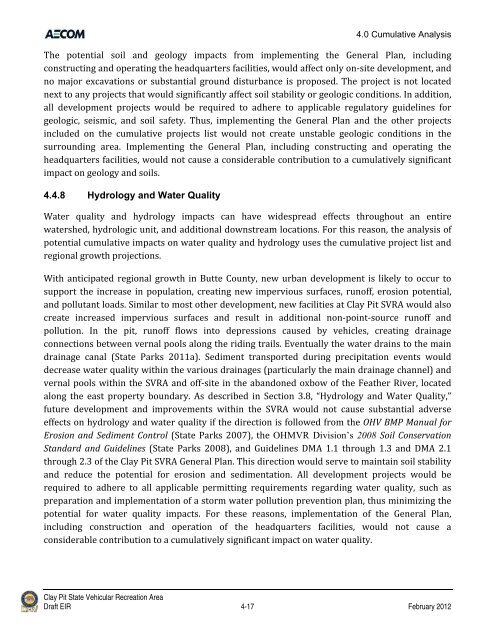Draft Environmental Impact Report - California Off Highway Vehicle ...
Draft Environmental Impact Report - California Off Highway Vehicle ...
Draft Environmental Impact Report - California Off Highway Vehicle ...
You also want an ePaper? Increase the reach of your titles
YUMPU automatically turns print PDFs into web optimized ePapers that Google loves.
4.0 Cumulative Analysis<br />
The potential soil and geology impacts from implementing the General Plan, including<br />
constructing and operating the headquarters facilities, would affect only on‐site development, and<br />
no major excavations or substantial ground disturbance is proposed. The project is not located<br />
next to any projects that would significantly affect soil stability or geologic conditions. In addition,<br />
all development projects would be required to adhere to applicable regulatory guidelines for<br />
geologic, seismic, and soil safety. Thus, implementing the General Plan and the other projects<br />
included on the cumulative projects list would not create unstable geologic conditions in the<br />
surrounding area. Implementing the General Plan, including constructing and operating the<br />
headquarters facilities, would not cause a considerable contribution to a cumulatively significant<br />
impact on geology and soils.<br />
4.4.8 Hydrology and Water Quality<br />
Water quality and hydrology impacts can have widespread effects throughout an entire<br />
watershed, hydrologic unit, and additional downstream locations. For this reason, the analysis of<br />
potential cumulative impacts on water quality and hydrology uses the cumulative project list and<br />
regional growth projections.<br />
With anticipated regional growth in Butte County, new urban development is likely to occur to<br />
support the increase in population, creating new impervious surfaces, runoff, erosion potential,<br />
and pollutant loads. Similar to most other development, new facilities at Clay Pit SVRA would also<br />
create increased impervious surfaces and result in additional non‐point‐source runoff and<br />
pollution. In the pit, runoff flows into depressions caused by vehicles, creating drainage<br />
connections between vernal pools along the riding trails. Eventually the water drains to the main<br />
drainage canal (State Parks 2011a). Sediment transported during precipitation events would<br />
decrease water quality within the various drainages (particularly the main drainage channel) and<br />
vernal pools within the SVRA and off‐site in the abandoned oxbow of the Feather River, located<br />
along the east property boundary. As described in Section 3.8, “Hydrology and Water Quality,”<br />
future development and improvements within the SVRA would not cause substantial adverse<br />
effects on hydrology and water quality if the direction is followed from the OHV BMP Manual for<br />
Erosion and Sediment Control (State Parks 2007), the OHMVR Division’s 2008 Soil Conservation<br />
Standard and Guidelines (State Parks 2008), and Guidelines DMA 1.1 through 1.3 and DMA 2.1<br />
through 2.3 of the Clay Pit SVRA General Plan. This direction would serve to maintain soil stability<br />
and reduce the potential for erosion and sedimentation. All development projects would be<br />
required to adhere to all applicable permitting requirements regarding water quality, such as<br />
preparation and implementation of a storm water pollution prevention plan, thus minimizing the<br />
potential for water quality impacts. For these reasons, implementation of the General Plan,<br />
including construction and operation of the headquarters facilities, would not cause a<br />
considerable contribution to a cumulatively significant impact on water quality.<br />
Clay Pit State Vehicular Recreation Area<br />
<strong>Draft</strong> EIR 4-17 February 2012








